
Garrett Peabody on the tower, approaching the sprinkler heads for adjustment. The adjustment process can be a decidedly unpleasant task, as it can only be done 55 feet in the air, in the cold, with water spraying all over you. [Photo] Courtesy of Jeff Shoemaker
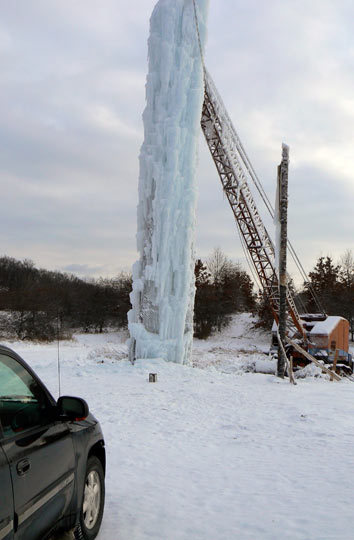
Despite its length and apparent hardship, the arduous approach to the tower is actually short enough to allow quick lunch-time climbing sessions and after work burns. [Photo] Luke Bauer
The lucky ones find superb climbing in their backyard year-round. Most of us–not quite so pampered–drive varying distances depending on the time of year. For others, there’s no vertical enjoyment within a reasonable day’s drive, no matter the season.
What follows is a story–the first in a multi-part Weekly Feature series on climbing obsession and ingenuity–of a 57-foot ice tower in Fenton, Michigan. If going to the climbing takes too long, why not bring the climbing closer?
But why open the series with Fenton’s vertical anomaly? It’s not very tall, and it’s certainly not very wide, and fewer than a hundred people have ever climbed there. What gives? Well, as Garrett and Jeff would likely tell you, every big idea starts out small–though in this case, the initial engineering began a little too small, as you’ll see. To honor those who indulge and share their climbing obsession creatively, we, too, will start out small. Enjoy.
GEOLOGIC BANALITY-0, FEN-TUCKY-1
“There can be no vulnerability without risk; there can be no community without vulnerability; there can be no peace, and ultimately no life, without community.”
–M. Scott Peck

The harsh conditions of the belay station. [Photo] Courtesy of Garrett Peabody
Being an ice climber in Michigan is, like many things in the Midwest, a little, well, odd. Rather than an off-season, Michigan has three off-seasons and one all too brief on-season. This state of affairs is compounded by the lack of any significant topographical relief.
The three months (if you’re lucky) of joy for most Midwestern ice climbers are filled with long, sleepless drives to Ontario, Northern Minnesota and Michigan’s Upper Peninsula. There are even a few weekends each season with ice festivals. In Munising, Michigan, and Sandstone, Minnesota, people come together for long weekends of gear demos, slideshows, gear raffles, free beer and a hearty dose of socializing with new partners and old friends. Unlike more well-known festivals in Ouray, Colorado, and Hyalite Canyon, Montana, where multiple climbs are easily accessible from the hotel’s hot tub, even meccas of the Midwest still necessitate a long snowshoe or ski to widely scattered curtains, diminishing the social aspects of climbing, even during festivals. But the gatherings are the driving force in a part of the country whose climbing scene is based more on tenacity, stubbornness and a sense of belonging than on what most climbers would consider great climbing.
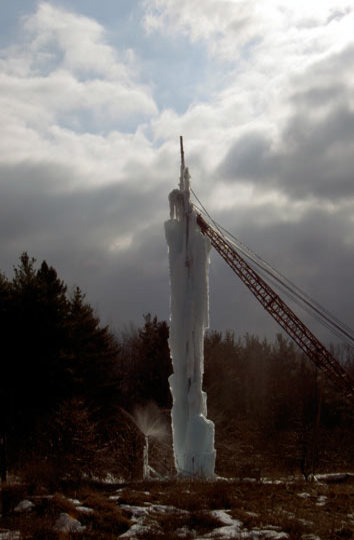
The last days of the season melt away. The sprinkler at the bottom of the tower was Brittany Schram’s addition to the construction. The spray fills out the lower sections which would otherwise be rather thin. Plans for next season’s tower, and festival, are even bigger. [Photo] Courtesy of Jeff Shoemaker
Thankfully, two visionaries in Fenton, Michigan, have solved both problems of geologic banality that plague all parts of the Midwest not immediately adjacent to Lake Superior, and the dearth of available festival weekends. They built a tower, put sprinkler heads on it, waited until some ice formed, then had a festival.
Garrett Peabody, a 27-year-old insurance salesman, and Jeff Shoemaker, a 28-year-old owner of a landscaping company, realized that they were trapped in a flat place with absolutely no chance of natural ice. “We started by climbing in the storage cooler walls out at the farm,” Garrett said, but they soon realized that insulating foam didn’t have much structural stability. “That’s when we decided to build a tower.” Conveniently, they had access to an abandoned apple orchard, a crane, and an abundance of creativity.
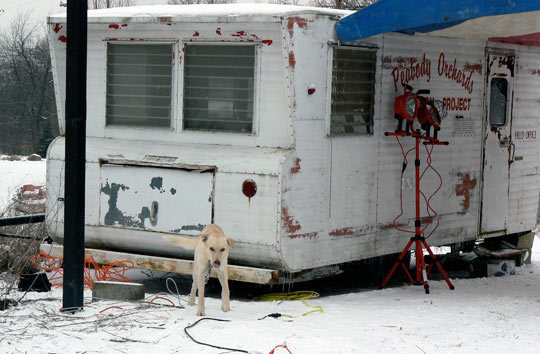
The grandeur of the warming lounge may be lackluster–or rusted–on the outside, but it’s plush shag carpet interior and mildly dangerous open propane heaters provide such an ambiance that even the canine ice climbing contingent keeps coming back. [Photo] Luke Bauer
The first attempt was simply a rope running down from the crane arm, but the formation quickly collapsed from the weight of the ice.
The second attempt was two 37-foot poles wrapped in chain link fence and attached to the crane arm. It didn’t collapse, but it wasn’t very tall, or stable.
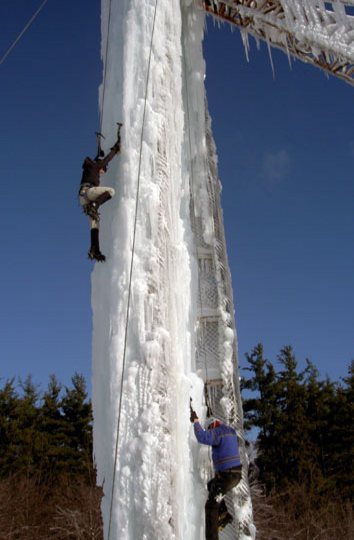
Brittany Schram, on the left, and an unidentified participant on the right, climb opposite sides of the tower during the sunshine and mild temperatures of the Fen-tucky Ice Fest, January 2007. [Photo] Courtesy of Garrett Peabody
Finally, with three 70-foot trees, the aforementioned crane, an unused farm well, 250 feet of plastic tubing, some landscaping-grade sprinkler systems borrowed from Jeff’s business, a lot of two by fours, an unmentionable amount of chain-link fence and 30,000 gallons of water, the third edition of the tower was a success.
“If you have temps below 20 degrees, you can build the tower with proper adjustments on the heads–that has to be done while the water is running and you are 55 feet in the air with the wind blowing and water freezing to you–in about three days. It takes much longer if weather is around 25 degrees,” Jeff reports. Fifty-seven feet high, mildly overhanging on one side, the new structure featured enough to provide quite a few different routes.
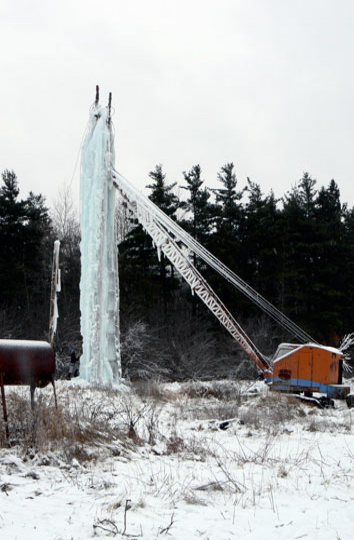
[Photo] Luke Bauer
Now that the gentlemen had a tower, it was time to have a festival.
Owing to the rural nature of Fenton, Michigan, and the originators’ extensive time climbing rock in Kentucky’s Red River Gorge, the festival was eventually dubbed the Fen-tucky Ice Fest and was held over a weekend in late January of 2007. Attended by more than seventy people, it “went off without a hitch.”
Participants, mostly friends and family of the builders–and one Finnish couple–with some acquaintances of acquaintances ranging from as far away as Ontario, Kentucky, and Wisconsin, found the two top ropes and the remarkably long-lasting keg to be a satisfying way to spend the day.
Next to the tower was a ca. 1950 mobile home–decidedly lacking in mobility these days–decked out with propane heaters, ashtrays and shag carpeting. This became the warming trailer: a lounge, of sorts, for those participants less familiar with the rigors of belaying in the cold from the comfort of a lawn chair.
“My mom got up about fifteen feet and had a blast. The typical rest time between laps was about the time it took to drink a beer, and we lucked out with fantastic weather for the day,” Garrett said.
When darkness fell, the party moved inside the nearby barn, where Mr. Peabody’s brother had constructed a bar, christened Dirty Ernie’s after the farm’s old tractor mechanic. The party lasted well into the night, while acquaintances of acquaintances became friends. “Next year we’re going to have a bluegrass band.”
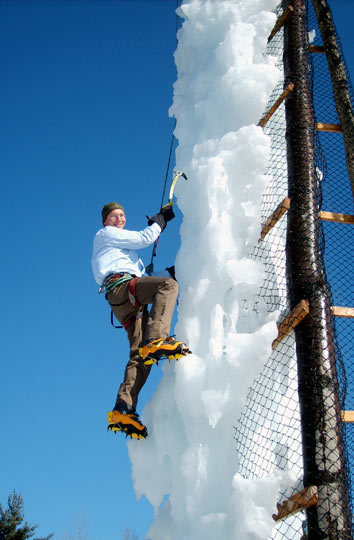
Jeff Shoemaker, showing off the latest in business casual ice climbing attire. [Photo] Courtesy of Garrett Peabody
“Though we still spend most weekends in the car, we can now spend our lunch hours climbing ice in khakis, and our evenings climbing ice by headlamp. Sometimes, however, the tower’s proximity to civilization makes it a little trying. A bystander, watching us one day, said, “Why didn’t you build it higher? You have way more rope.”
For information on the upcoming Fen-Tucky Ice Festival, tentatively targeted for Saturday, January 12, 2008, send an email to the organizers.
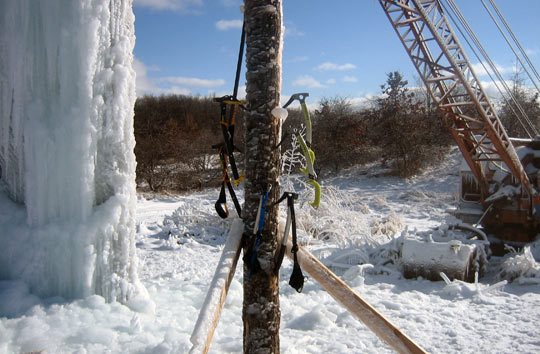
Community tool storage. [Photo] Courtesy of Jeff Shoemaker